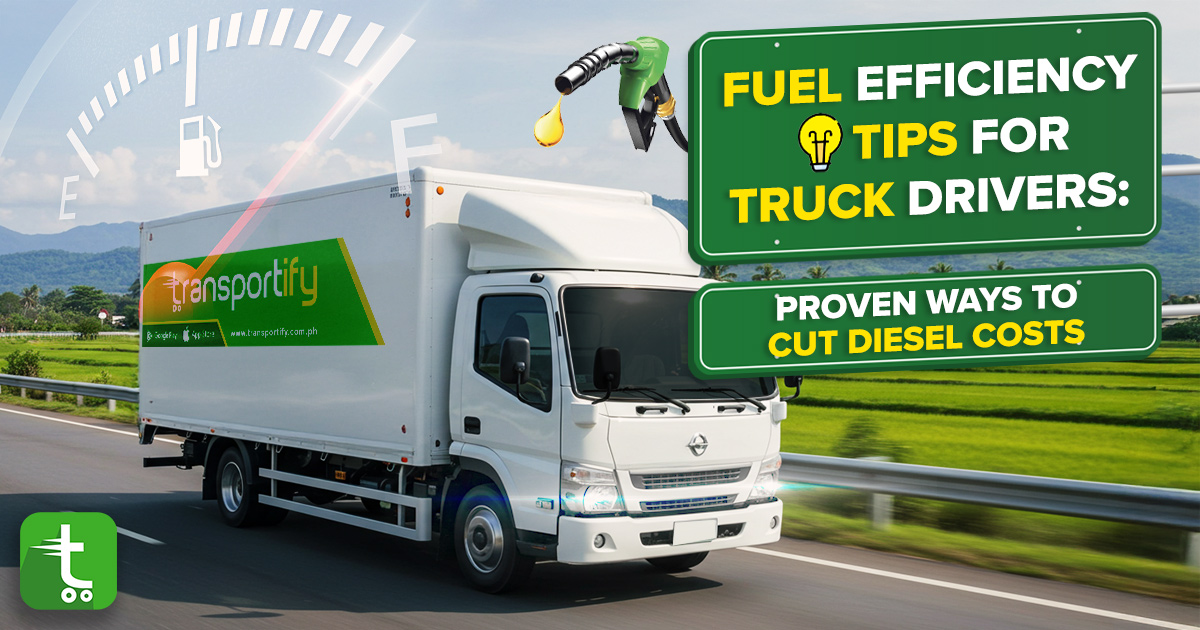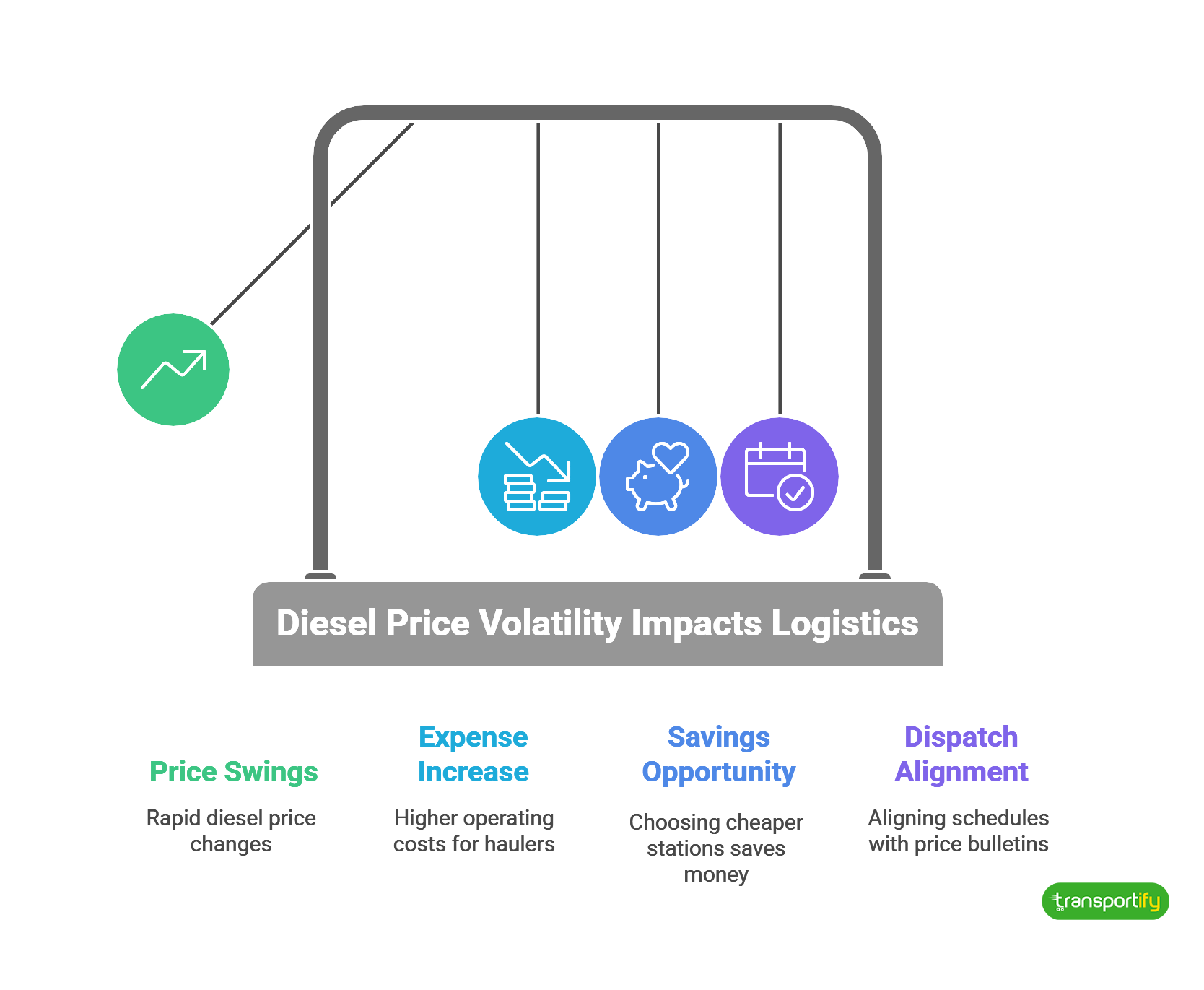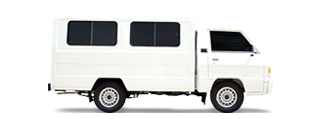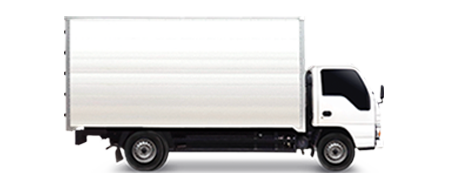
Fuel efficiency is no longer just a technical issue for truck drivers, it’s a survival strategy in the Philippines’ volatile fuel market. According to Philippine Statistics Authority, with diesel costs swinging weekly and transportation consuming 34.8% of the country’s total energy use, every wasted liter cuts directly into operator margins. Road transport alone eats up over 90% of transport energy demand, making trucks a critical pivot point in reducing both costs and emissions.
This guide provide practices, from RPM management to route planning around Metro Manila truck bans, so truck drivers and fleet managers can capture fuel savings in 2025’s challenging conditions.
Diesel Price Exposure in the Philippines: Where the Pesos Go
The Department of Energy’s Oil Price Monitor shows how quickly diesel can swing. In June 2025, prices rose ₱0.95/L one week and ₱1.80/L the next. For fleets burning hundreds of liters per run, this volatility translates to thousands of pesos per trip. That’s why fuel is consistently 30–40% of operating expenses for haulers in the logistics industry.

What does NCR’s weekly pump-price dispersion tell a driver?
In the DOE’s NCR monitoring sheet, posted prices ranged from ₱44.00 to ₱61.70/L in just one week. If you fill a 200-liter truck tank, choosing the cheapest station avoids about ₱3,540 compared to the priciest option, practically a free provincial delivery for some trucking company services.
How fast are prices moving in 2025?
Inquirer report shows weekly shifts of ₱1.00–₱1.50/L, underscoring the risk for operators who refuel at the wrong time. Smart fleets align dispatch schedules with DOE price bulletins to smooth expenditures across the logistics industry.
Congestion Math: Why Metro Manila Traffic burns Diesel
Stop-go driving is poison for fuel economy. The TomTom Traffic Index ranks Metro Manila among the world’s slowest: 25 minutes, 30 seconds per 10 km (~19 km/h). That alone eats about 117 hours per driver per year.
What time-of-day and detour choices matter most?
Rush hours slash speeds to near 19 km/h, per Inquirer traffic analysis. Fleets that shift dispatch to midnight–5 AM windows consistently post better fuel returns.
Empty Miles & Backhaul: The Biggest Local Waste
According to Clean Air Asia, more than 56% of inbound freight trips arrive empty, and 79.4% of trailers leave without loads. Shippers often pay two-way rates just to cover this inefficiency, which bloats both costs and emissions for trucking company services.
What dispatch fixes reduce PH empty trips?
- Freight exchanges for load-matching
- Co-loading small consignments
- Using Batangas or Subic instead of congested Manila for container pulls
These strategies reduce empty returns and immediately cut liters burned.
How large is fuel in PH operators’ OPEX?
Surveys put fuel at 30–40% of total expenses. Every avoided kilometer of deadhead directly reduces operator vulnerability.
Fleet Age &Road Conditions: Hidden Drivers of Fuel Burn
More than 80–90% of trucks are 15+ years old, many operating below Euro-IV standards, according to the OECD logistics sector review. Coupled with rough pavement and 16% overloading rates (JICA freight report), rolling resistance and fuel inefficiency escalate.
Practical PH steps short of buying new trucks
- Monthly alignment checks
- Early injector and filter swaps
- Investing in low rolling resistance tires
- Staying within legal axle-loads before filing a Certificate of Public Convenience
Refueling Strategy: price spreads you can exploit
The DOE’s NCR pump sheet shows ₱10–₱17/L station spreads. For a 600 L fill-up, that’s ₱6,000–₱10,200 in avoidable cost, a make-or-break margin for independent operators in trucking company services.
Should you plan out-of-Manila fuel stops?
Yes, regional monitors like North Luzon’s DOE listings often show lower diesel than NCR. Coordinating refuel stops during provincial trucking services loops boosts savings.
Enroll Your Van or Truck and a Truck Driver in Transportify
Starting a trucking business in the Philippines doesn’t always mean buying a whole fleet or competing directly with large logistics firms. Many owner-operators successfully begin by enrolling a single truck or van and a trusted truck driver into tech-enabled delivery platforms like Transportify.
This step is often described as the “easy part” of launching, because it immediately connects your vehicle to thousands of active shippers and corporate clients who need freight moved, without the heavy marketing or client acquisition costs most new trucking companies face.
What Vehicles Can Be Enrolled?
ss multiple trucking services in the Philippines.
 |
Transportify accepts a range of commercial vehicles that match customer needs:
- Small utility vans and L300s (ideal for e-commerce fulfillment and point-to-point city deliveries)
- Dropside trucks (popular for construction and infrastructure logistics needs)
- 6-wheeler and 10-wheeler trucks (for provincial deliveries and bulk cargo)
- Wing vans and larger truck classes (for enterprise loads and containerized goods)
These options allow both part-time side hustlers and full-time logistics entrepreneurs to join with the assets they already own.
Key Benefits of Enrolling in Transportify
- Instant Market Access – Once approved, your vehicle and driver can accept bookings from thousands of SMEs, online sellers, and corporations across NCR, Luzon, Visayas, and Mindanao.
- Flexible Earning Potential – Drivers and operators choose bookings that fit their schedules and routes, maximizing utilization and minimizing empty miles.
- Transparent Payouts – Weekly earnings for each completed booking, deposited directly, making cash flow easier to manage.
- Digital Operations – The app optimizes routes and avoids common congestion zones.
- Lower Entry Risk – Many small operators start with platform-based work and scale up gradually.
Why This Matters for Fuel Efficiency and OPEX
By connecting to a platform, you minimize:
- Empty returns (backhaul opportunities are higher)
- Idling while waiting for loads (immediate access to bookings reduces downtime)
- Marketing costs (shipper acquisition is handled by the platform)
For new trucking entrepreneurs, this partnership model lowers risk while still teaching the operational realities of running logistics in the Philippine market. Over time, operators can upsize their fleet, apply for their own contracts, or diversify across multiple trucking services in the Philippines.
 | or |









 Chat
Chat